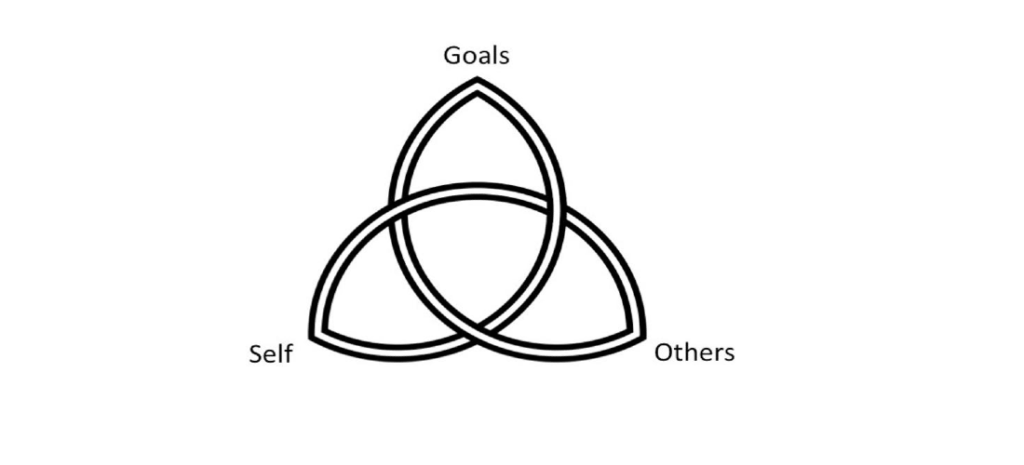
Warren Bennis, one of the founders of the modern study of leadership, was known for this provocative statement: “I don’t know if leadership can be taught … but I believe it can be learned.”
Bennis believed that leaders are formed via “crucible moments”: formative events, critical struggles, or serious challenges that force people to learn, grow and think differently about themselves. However, most of us don’t get to experience “crucible moments” on a regular basis—which is probably a good thing, since these events can be exhausting and disruptive! In the absence of crucibles, how can you catalyze your own development as a leader?
That is why The Leadership Triangle can be helpful. Growth as a leader is anchored in three fundamental aspects: clarifying and prioritizing your GOALS; deepening your understanding of the OTHERS you must engage and influence, and developing keener knowledge and awareness of YOURSELF. Furthermore, each of these aspects is dynamically dependent on the other aspects.

The Leadership Triangle (Source: NEVINS CONSULTING, INC.)
GOALS
Start with GOALS, which are usually about change: innovating, growing, contending with disruption, getting people or a business from here to there. If there is no change there is no need for leaders, only managers. Goals must be few, specific, and prioritized: laying out dozens of important broad goals for the next 12 or 18 months is about as useful as laying out no goals at all. Their generality and equal weight won’t guide you, and in any case you’ll never accomplish that many. If everything is important, then nothing is important.
Goals can have several levels or even layers, like onions. As an executive, you may have goals for this quarter or for a specific project. You may have goals for this year; for your current role or employment for the next several years; for your career; And even for your life in the long run. Goals should relate to both strategy and purpose: for yourself, your followers, and your organization. Clarity about goals is essential – which is why companies put so much effort into long-term planning and setting strategic goals. (And what do you decide? not Focusing on it is just as important as what you choose to pursue.)

Be clear and prioritize your GOAL
GOALS, of course, link directly back to both OTHERS and SELF. How do you engage and empower others to accomplish those goals? Why are those goals important to you and your stakeholders? And which tasks related to achieving those goals should you tackle yourself, or where do you most need someone else’s skill set or perspectives?
OTHERS
The second point in the triangle is OTHERS. If you are a leader, you are by definition not an individual contributor; Thus achieving your goals requires you to do things with and through others. As a first step, it is essential that you make sure that everyone is working with the same goals and values in mind. Furthermore, the people you lead, are influenced by and collaborate with, need to have a connection to the goals – ideally co-authors of the vision or mission. If your goals aren’t meaningful or important to stakeholders (which may include your team, peers, clients, bosses, and others), they’ll quit: never forget how important Goal To motivate and mobilize people.
Not every stakeholder will agree with your goals, so make sure you have the critical mass of support you need, and that you have plans to keep dissenters from derailing you. Looking ahead to the third corner of the Triangle, you must also to understand how others experience YOU: Are your values and leadership philosophy clear to them? Do they feel they can have open communication with you, that you listen, and that you care about what’s important to them? You must be thoughtful and disciplined about how you engage and manage your stakeholders, build high-performing teams, and coach and develop the people you are responsible for. This OTHERS corner of the Triangle underscores the rationale for practices such as 360-reviews and soliciting feedback.
SELF
We’ve saved the third corner of the Triangle, YOURSELF, for last because much of today’s formal leadership development and executive coaching focuses here. But if you disregard OTHERS and GOALS, you risk becoming a self-aware person who fails to motivate others and achieve results. Self-understanding is critical: as Socrates (one of the first recorded teachers of leadership) famously advised: “Know Thyself.” But for leaders, self-understanding is a means to an end, not an end in and of itself.

Leaders need to identify knowledge and self-perception
True and authentic self-knowledge and self-awareness are essential to all leaders: What am I good at – and what am I good at? What do I like to do? What are my values and what really motivates me? What kind of leader do I want to be and why? But self-awareness must be enlightened by our understanding of others Also: How do I connect with others when I’m at my best — and I’m not at my best? What do stakeholders need from me, and how can I provide that for them? Increasing your self-understanding should also bring you back into your life.
Do you really need a leadership triangle?
Leadership development is, obviously, a vast topic; entire libraries could be filled with books addressing it. This article only scratches the surface, and rather than trying to offer pat answers, the desire here is to illustrate the helpfulness of the Triangle of GOALS, OTHERS, and SELF for thinking about your own development as a leader. Focus on only one or two of these corners and you will almost certainly be an incomplete leader.
“Leadership maybe It can be learned. What is your plan?”
Source: Forbes
——————————————–
>> Explore the top management jobs today or refer suitable candidates
>> View more: Building 5 Characteristics of a Positive Workplace Culture
>> View more: 6 Important Success Factors For The Innovation
PRIMUS – TOP MANAGEMENT JOBS ONLY






